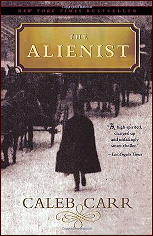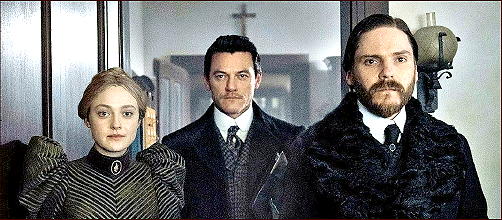Tue 23 Jan 2018
An Archived Review by Walter Albert: CALEB CARR – The Alienist.
Posted by Steve under Reviews[8] Comments

CALEB CARR – The Alienist. Laszlo Kreizler #1. Random House, hardcover, 1994. Bantam, paperback, 1995. TV adaptation: A ten-episode series premiered on TNT on January 22, 2018, with Daniel Brühl as Dr. Laszlo Kreizler, Luke Evans as John Moore, and Dakota Fanning as Sara Howard.
The time is 1896, the place, New York City, at a time when Theodore Roosevelt, president (1895-1897) of the Board of Commissioners of New York City’s Police Department, is attempting to rid the Department of its corruption and inefficient antiquated methods, and open it up to “modern” ideas and procedures.
Roosevelt’s struggle with the law enforcement establishment are mirrored in the attempts of his friend, Dr. Laszlo Kreizler, a psychologist (or alienist) to reform a profession opposed to believing that psychopaths are “produced by extreme childhood environments and experiences and [are] unaffected by any true pathology. Judged in context, the actions of such patients could be understood and even predicted (unlike those of the truly mad).” Or as the reporter-narrator puts it, “[we] set out on the trail of a murderous monster and ended up face to face with a frightened child.”
Kreizler and Roosevelt are seen as threatening not only the beliefs of a profession but society itself. Thus, Kreizler and his team, hastily formed to discover the sadist who is killing and mutilating boy prostitutes, must operate secretly, and independently of the police.

Carr has some of the ability to bring to life a historical period but does not quite seem to make the period as immediate as the present. His portrait of a period has more of the appearance of a brilliantly realized oil painting. It’s no less effective, perhaps, but it lacks the evocative power of cinematic realism. In one, the tableau moves; in the other, it glows with something of a romantic sheen.
Carr doesn’t escape what might have become the conventions of the serial murder novel; in particular, the use of another murderer to shed some light on the mind of the subject of present investigation. As in Thomas Harris’s Red Dragon and The Silence of the Lambs, the investigator visits the incarcerated “specialist.” This time, it’s one Jesse Pomerpy, described in a manner that has something of the gothic flavor of the Hannibal Lector descriptions: “Pomeroy was wearing a heavy set of shackles on his wrists, and an iron ‘collar cap’ rested on his shoulders and surrounded his head. This latter device , a grotesque punishment for particularly unruly prisoners, was a two-foot0high barred cage. Despite both the shackles and the collar cap, however, Jesse had book in his hand and was quietly reading.”
The Alienist is in the fourth spot this week on the NY Times bestseller list. There are apparently a lot of readers whose “escape” reading is hardly an opening onto a panorama scarcely less horrific than the one depicted in the daily newspaper and on TV. Highly recommended, if you can stomach the graphic descriptions of mutilated bodies and irruptions of violence.

January 23rd, 2018 at 10:19 pm
An entertaining book as bestsellers go, but the series comes 25 years too late with everything done and from what I saw, done better.
In some ways it’s what hurt John Carter having already had Flash Gordon and Star Wars. Sometimes it’s too little too late.
January 24th, 2018 at 1:02 pm
I read this book when it first came out back in the 90s. Astonishing the parallels that Carr found with 19th sex clubs/prostitution and modern day human trafficking. Jesse Pomeroy was a real person but I didn’t see any resemblance to Hannibal Lecter. I don’t think Carr put Pomeroy in the book as Lecter stand-in. The novel is meant to show how times have not at all changed. I noticed that Ted Levine is in the cast. He played the killer in Silence of the Lambs. In THE ALIENIST Levine is playing real life 19th century policeman Inspector Thomas Byrnes who has been credited with inventing the interrogation technique known as the “third degree”.
Anyone watching the new TV series? Despite what David says I know it will find an audience. I’m trying to find out if I can view it using my Amazon Prime membership. Probably have to fork over more money. I don’t have cable TV because I’ve never seen the point in paying for all that TV that I’ll never watch. Now look at me!
January 24th, 2018 at 3:49 pm
On the recommendation of a friend I began watching this from the beginning and found it interesting enough to try to remember to tune it in next week and see how it develops. I have not read the book, but I had a copy at one time. The review here says the TV adaptation is eight weeks, but somewhere I read that there are 10 episodes.
January 24th, 2018 at 6:23 pm
You’re right, Randy. Wikipedia says it’s a 10 episode series. I’ll change that.
And for what it’s worth, over 600 people on IMDb have given it 8.1 stars out of 10 so far. Keep in mind that this is the kind of television fare that people who like this kind of television fare really like.
People like me who won’t be watching aren’t going to be voting either.
January 26th, 2018 at 2:33 pm
I read the book (and the sort of sequel) when it first came out. The only thing I remembered about it was the darkness and the idea that the land where the NY Public LIbrary stands was once a reservoir. Hard to fathom.
But when, for whatever reason, I tried re-reading the book last year sometime, I just couldn’t get into it and the writing seemed off somehow. Not as good as I’d remembered. I hate when that happens.
I won’t be watching the series. I kind of agree: the timing is wrong.
January 26th, 2018 at 6:48 pm
Yes. For whatever reason, it’s often a lot more difficult than it should be to go back home again.
January 27th, 2018 at 10:03 am
The Alienist was my first iPod audiobook and I was hooked. In the book, New York City is as much of a character as anyone and it sounds from the reviews that they really paid attention to detail. I hope it shows – I have the first episode in the can (on my DVR) to watch this weekend.
November 9th, 2018 at 12:26 pm
An entertaining book as bestsellers go, but the series comes 25 years too late with everything done and from what I saw, done better.